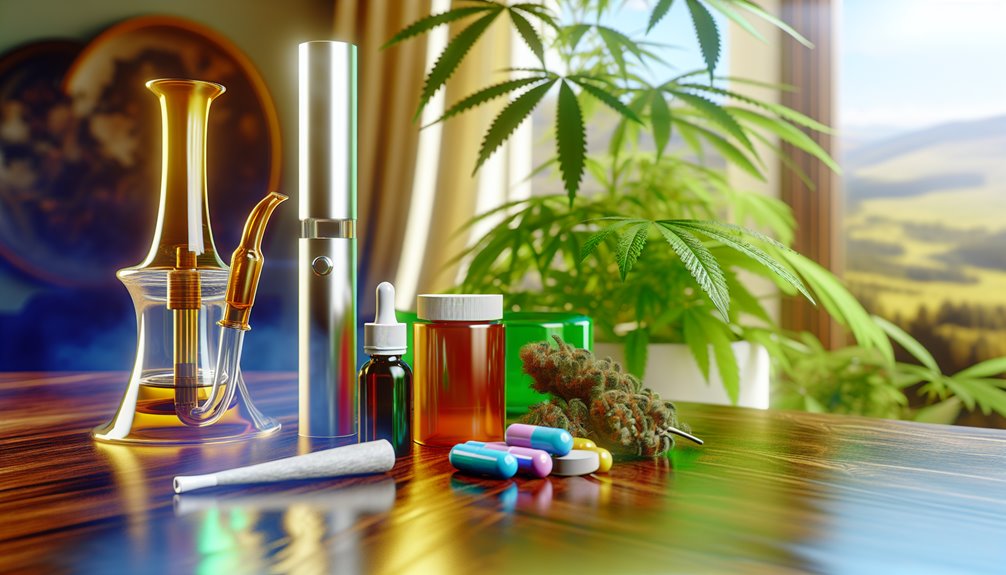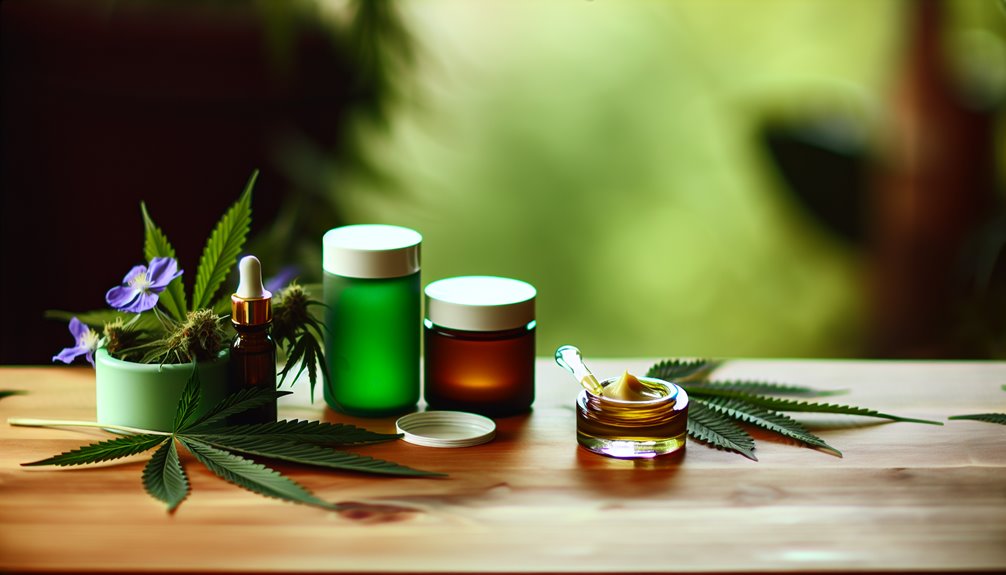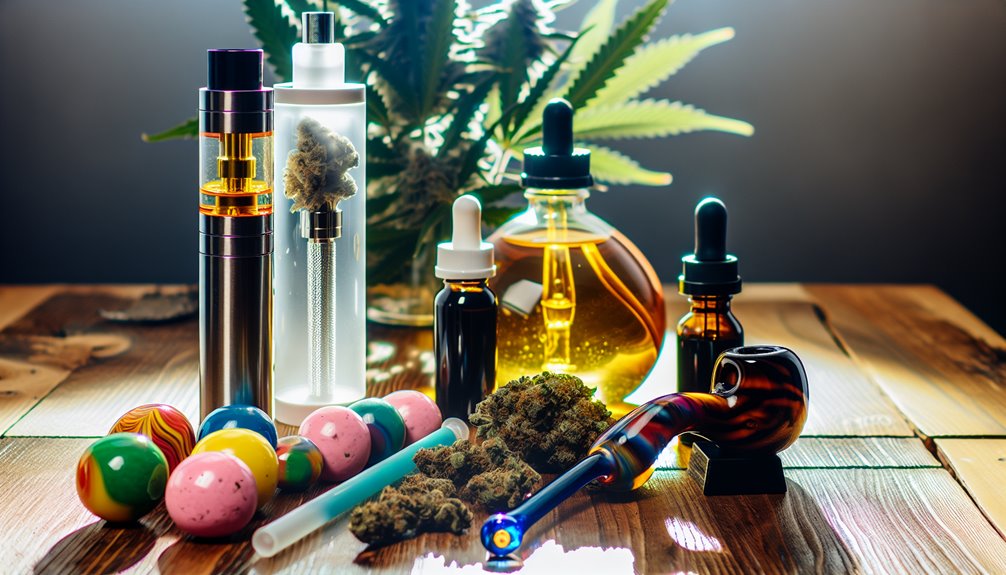While you might associate cannabis consumption with smoking, the world of medical cannabis offers a diverse range of methods tailored to individual needs and preferences. From vaporizing and edibles to tinctures, topicals, and transdermal patches, each method presents unique advantages and considerations. This variety enables precise control over dosage, onset time, duration of effects, and the ability to target specific symptoms or areas of discomfort. Maneuvering this spectrum of options can seem overwhelming, but with professional guidance, you can access the therapeutic potential of medical cannabis. Stick around to discover more.
Understanding the Basics of Medical Cannabis Consumption

While exploring the topic of medical cannabis consumption, it's essential to understand the various methods of intake that can greatly affect your experience. Vaporizing cannabis, for instance, offers immediate effects that can last between two to six hours. The benefits of vaporizing include its discretion, the absence of harmful byproducts, and compatibility with both dried flowers and concentrates. On the other hand, ingestion, though ideal for precise dosing and long-lasting effects, presents challenges like delayed onset and difficulty in achieving the desired effect. It's also crucial to note that topical creams or patches can provide localized pain relief without the psychoactive effects commonly associated with cannabis. It's vital to experiment under professional guidance and find the best intake method for your needs. Remember, each method has its unique aspects. Your understanding of these can considerably influence your medical cannabis experience.
An In-Depth Look at Consuming Medical Cannabis Through Smoking
Shifting our focus to smoking, another method of medical cannabis consumption, we find a technique as old as human interaction with the plant itself. You can smoke cannabis using traditional pipes, water pipes, or rolling papers. This method offers almost instant relief, making it a preferred choice for those seeking immediate symptom reduction. However, smoking techniques come with health impacts. Combusting the plant releases harmful byproducts like tar and carbon monoxide, potentially causing lung irritation and respiratory issues. While it's easy to control dosage via smoking, it's also less discreet and can affect those around you due to the smoke. If you're concerned about these drawbacks, alternatives like vaping or metered-dose inhalers offer healthier methods of consumption. It's worth noting that those new to medical cannabis consumption should approach smoking with caution and start with lower doses to prevent potential overconsumption overconsumption.
The Rise and Role of Cannabis Edibles in Medical Treatment

As the popularity of medical cannabis grows, so does the rise of cannabis edibles, becoming a significant player in medical treatment. For many patients, edibles offer a discrete and effective way to consume cannabis. Their extended relief from chronic pain, anxiety, and digestive disorders surpasses other forms of consumption. But creating these edibles isn't as simple as sprinkling cannabis into a brownie mix. Specific cooking techniques are required to activate the cannabis's medicinal properties. Moreover, dosage guidelines are essential. Too little and you won't feel the effects, too much and it could lead to uncomfortable experiences. As the medical community continues to unravel the benefits of cannabis edibles, it's clear they play a pivotal role in patient treatment.
Exploring the Benefits of Cannabis Tinctures for Patient Use
Numerous benefits make cannabis tinctures an excellent choice for patients seeking relief from various medical conditions. They provide pain relief, manage depression and anxiety, and alleviate cancer-related symptoms. Their neuroprotective and anti-inflammatory properties are also significant. Tinctures offer three methods of administration: sublingual, oral, and topical. The sublingual benefits include fast-acting relief, kicking in within 15 minutes. Precise tincture dosage is feasible, thanks to dropper caps. Compared to other methods, tinctures offer a smoke-free alternative, reducing respiratory risks. They boast a long shelf life and versatile usage. Using full-spectrum, broad-spectrum, or isolate tinctures allows patients to target specific needs. For those seeking a safe, effective, and personalized medical cannabis solution, tinctures are a promising option.
The Science Behind Topical Cannabis Applications

While tinctures offer an effective means of cannabis use, another method that's gaining popularity is topical applications. These products contain cannabinoids like THC and CBD, designed to provide localized effects. Your skin is lined with cannabinoid receptors, creating a pathway for these compounds to deliver anti-inflammatory and analgesic results. However, the clinical data is limited, so it's key to approach with caution. The efficacy of topical cannabis isn't yet fully evidence-based. Adverse effects, such as rash or itching, have been reported. There's also a risk of systemic absorption and potential drug interactions. Be aware of label inaccuracies regarding CBD and THC content. While topical cannabis applications show promise, more research is needed to solidify their place in medical practice.
Transdermal Patches: A Unique Method of Medical Cannabis Delivery
Diving into a unique method of medical cannabis delivery, let's explore the world of transdermal patches. These patches are not just convenient, they also guarantee 100% medicinal value by bypassing metabolic pathways. You apply them to clean, dry skin, enjoying a controlled release of cannabinoids over several hours. Transdermal patch benefits include whole-body relief, discreet use, consistent dosing, and long-lasting effects. They're a non-invasive alternative especially beneficial for chronic pain relief, reducing psychoactive effects, and minimizing paranoia. Patch application techniques involve choosing sites with good circulation, like your inner arm or leg, and rotating these sites to prevent skin irritation. Remember, these patches offer a unique, steady, and effective way to experience medical cannabis.
Considering the Pros and Cons of Different Cannabis Consumption Methods

From exploring the world of transdermal patches, we now turn our attention to an in-depth look at the various cannabis consumption methods available. Let's consider their pros and cons.
- Inhalation: The inhalation advantages are notable. It provides rapid onset of effects and high bioavailability, making it effective for swift symptom management. However, concerns about lung irritation and respiratory issues are valid.
- Ingestion: Ingestion drawbacks can't be overlooked. Although it offers long-lasting effects, it has lower bioavailability and dosing challenges due to variability in absorption and potency.
- Topicals and Sublingual: These offer localized relief and controlled dosing respectively, without the systemic effects of other methods.
Understanding these trade-offs can help you make informed decisions about the best consumption method for your needs.
Conclusion
Choosing the right method of medical cannabis consumption hinges on your specific needs and lifestyle. For instance, a cancer patient might prefer a tincture for precise dosing, while a chronic pain sufferer could opt for a transdermal patch for localized relief. Each method has its pros and cons, so consult with a healthcare professional. Ultimately, the goal is to maximize therapeutic benefits while minimizing potential risks, making informed decisions essential in your individual healing journey.
If you're curious to learn more about the best options for your situation, I warmly invite you to visit Fells Point Cannabis Docs of Maryland or give them a call at (410) 401-4200. The team there is friendly and knowledgeable, and they're ready to help you navigate your journey with medical cannabis. Don't hesitate to reach out; you deserve the support and information you need to make the best choices for your health!
